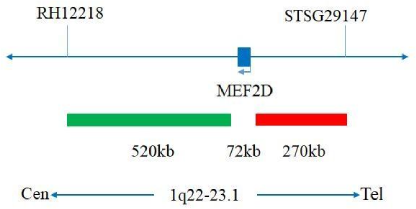Product Cat. No.: GBS-293
For Research Use Only
MEF2D (1q22) gene break apart probe reagent
10 Tests/box
The reagent carries out in situ hybridization staining on the basis of routine staining to provide doctors with auxiliary information for diagnosis.The test results are only for clinical reference and should not be used as the only basis for clinical diagnosis. Clinicians should comprehensively judge the test results in combination with the patient’s condition, drug indications, treatment response and other laboratory test indicators.
Fluorescence in situ hybridization is a technique for directly observing specific nucleic acids in cells in vitro. According to the principle of base complementary pairing, the specific probe is complementary to the target sequence in the cell. Due to the fluorescence of the probe, the gene state of the hybrid probe and the target sequence can be clearly observed under the fluorescence microscope under the appropriate excitation light.
The kit consists of MEF2D dual color probes, as shown in Table 1.
| Component name | Specifications | Quantity | Main components |
|---|---|---|---|
| MEF2D dual color probe | 100μl/Tube | 1 | MEF2D Orange probe, MEF2D Green probe |

Keep sealed away from light at -20oC±5oC. The product is valid for 12 months. Avoid unnecessary repeated freezing and thawing that should not exceed 10 times. After opening, within 24 hours for short-term preservation, keep sealed at 2-8oC in dark. For long-term preservation after opening, keep the lid sealed at -20oC±5oC away from light. The kit is transported below 0oC.
Fluorescence microscopy imaging systems, including fluorescence microscopy and filter sets suitable for DAPI (367/452), Green (495/517), and Orange (547/565).
1. Sample collection: take 1-3ml of bone marrow cells anticoagulated with heparin sodium
2. Sample preservation: unfixed fresh bone marrow specimen (stored at 2-8°C for no more than 24 hours). after fixation, the cell suspension shall
be stored at -20±5°C for no more than 12 months; The prepared cell slides can be stored at -20±5°C for no more than 1 month. When the sample
storage temperature is too high or too low, or the cell suspension is volatilized excessively or polluted during storage, the sample will not be used
for detection.
1.Related Reagents
The following reagents are required for the experiment but not provided in this
2. Sample processing before hybridization:
3. Denaturation and Hybridization
The following operations should be performed in a darkroom.
4. Washing
The following operations should be performed in a darkroom.
5. Counterstaining
The following operations should be performed in a darkroom
10μl DAPI compound dye is dropped in the hybridization area of the glass slide and immediately covered. The suitable filter is selected for glass slide observation under the fluorescence microscope.
6. FISH results observation
Place the stained slides under a fluorescence microscope and confirm the cells area under a low magnification objective (10×). Under magnification objective (40×) a uniform cells distribution is observed. Then the nuclei FISH results are observed under the high magnification objective (100x).

Negative: 2 fusion

Positive: 1 orange 1 green 1 fusion
1. The results of this kit will be affected by various factors of the sample itself, but also limited by hybridization temperature and time, operating environment and the limitations of current molecular biology technology, which may lead to wrong results.
2. Users must understand the potential errors and accuracy limitations that may exist in the detection process.
1.This product is only used for in vitro diagnosis.
2.Please read this manual carefully before testing. The testing personnel shall receive professional technical training, and the signal counting personnel must be able to observe and distinguish orange and green signals.
3.When testing clinical samples, when the hybridization signal counting is difficult and the sample is not enough to repeat the retest, or the cell volume is not enough for analysis, the test will not provide the test results.
4.DAPI counterstaining agent used in this experiment has potential toxicity or carcinogenicity, so it is necessary to operate in the fume hood,wear masks and gloves to avoid direct contact.
5.All chemicals are potentially dangerous. Avoid direct contact. Used kits are clinical waste and should be properly disposed of.
Medical device Filing Certificate No.: ehxb No20200367
V1. 0 approval date: May 07, 2020
V1. 3 revision date: July 15, 2024
